In This Issue
Message From the
Executive Director
 Now Visit VSI Now Visit VSI
on Facebook
 And Twitter And Twitter
Donate Securely and
Support VSI Newsletter!
Stress and Vitiligo: The Link
What's On Your Mind?
- What can I use to color
my eyebrows??
New Vitiligo Survey: How Did
Vitiligo Affect Your Life?
Medical News Updates
- Clinuvel-Scenesse
Clinical Trial Update!
- Foam Steroid Treatment
Found to be Superior to
NB-UVB Phototherapy
- New Clinical Guidelines
Developed for Treating Vitiligo
- New Treatment Stops
Vitiligo in Mice
Research & Clinical Trials
Bibliography
Earn funding for VSI
When you Shop!
View Past Newsletters
- Spring Edition 2014
- Winter Edition 2013
- Fall Edition 2013
- Summer Edition 2013
- Spring Edition 2013
- Winter Edition 2012
- Fall Edition 2012
- Summer Edition 2012
- Spring Edition 2012
- Winter Edition 2011
- Fall Edition 2011
- Spring Edition 2011
- Winter Edition 2010
VSI Medical and Scientific
Advisory Committee
Pearl E. Grimes, M.D., Committee Chair
Ted A. Grossbart, Ph.D.
Sancy A. Leachman, M.D.
I. Caroline Le Poole Ph.D.
Mauro Picardo, M.D.
Nanette B. Silverberg, M.D.
Richard A. Spritz, M.D.
Alain Taieb, M.D., Ph.D.
Wiete Westerhof, MD, Ph.D.
For more information
on VSI's MSAC Click Here |
| |
| |
How to Log In:
Have you have forgotten your Login ID and/or Password?
No Problem!
Just go to the
Community Page
Scroll down to
the login box.
LOOK UNDERNEATH!
You'll see instructions to have them sent to the email address on your account. |
|
How to Log In:
Have you have forgotten your Login ID and/or Password?
No Problem!
Just go to the
Community Page
Scroll down to
the login box.
LOOK UNDERNEATH!
You'll see instructions to have them sent to the email address on your account.
|
|
| |
How to Log In:
Have you have forgotten your Login ID and/or Password?
No Problem!
Just go to the
Community Page
Scroll down to
the login box.
LOOK UNDERNEATH!
You'll see instructions to have them sent to the email address on your account.
|
|
| |
| Contact Us
Online
VitiligoSupport.org
Email Contact Us
Postal Mail Address
Vitiligo Support International
P.O. Box 3565
Lynchburg Va 24503
Phone
(434) 326-5380 |
|
Message From the Executive Director

 Dear Members and Friends of VSI, Dear Members and Friends of VSI,
Historically, a clear line has been drawn between physical ailments and emotions – especially in the western world. As such, it’s been very difficult to get many of those in medicine and science to acknowledge, much less embrace, the concept of a mind-body connection. Change in perspective often comes slowly in science. Just think about the reaction of the scientific community to Galileo’s insistence that the earth rotated around the sun – he was accused of heresy, and naysayers were adamant in spite of the proof he offered. It took years before Galileo was proved right and everyone embraced the concept.
The western world has generally viewed the physical and the spiritual as separate, but as new studies on the brain-immune connection have increased over the last couple of decades, the tide is finally turning. Science is increasingly finding evidence of the influence that stress and other emotions have on the body, and further, the influence illness can have on our mind and psychological well-being.
In this issue, we look into the mounting science behind the connection between the brain and our immune system. What role can stress play as a trigger in developing vitiligo? And, once someone has vitiligo, can stress make the disease worse? What about all the stress that having vitiligo brings? What is the potential that stress can cause flares and affect our quality of life and overall health? And, most of all, what can we do about it? These are some of the questions we asked, and we want to share what we have learned with you.
In addition to focusing on stress and vitiligo, we offer the latest medical and scientific news about vitiligo, information on clinical trials, and answer your questions in our regular feature, “What’s on Your Mind?” Our goal is always to provide information you can use to live your life with vitiligo to the fullest!
Sincerely,

Jackie Gardner
Executive Director
Your financial contribution is critical to enable VSI to continue offering information and support!
VSI depends on donations from each and every newsletter reader in order to provide this valuable resource
Please make a generous donation today!
Become a Supporting Member: Click Here
Make a General Donation Through VSI: Click Here
Make a General Donation with PayPal

|

|
This organization is a Silver-level GuideStar Exchange
participant, demonstrating its commitment to transparency. |

Stress and Vitiligo: The Link
  Norman Cousins was editor of the Saturday Review when he became ill in the 1970s with the autoimmune disease ankylosing spondylitis. Facing a dismal prognosis, he began watching comedies while in the hospital, ensured that laughter was integrated into his life, and ultimately fully regained his health. Cousins later became an Adjunct Professor of Medical Humanities at the University of California and a strong proponent of teaching future physicians about the importance of positive emotions on physical health. O. Carl Simonton, MD was a pioneer of what became known as psycho-oncology when he established a cancer center in the 1970s that promoted the positive impact of emotional support on survival. By the early 1980s, he was teaching meditation and visualization of positive outcomes to cancer patients. Even though he was called a quack by the American Cancer Society at the time, the first independent evidence proving that he was on to something was published in 1989 by investigators at Stanford University and the University of California Berkeley, who found that women with advanced breast cancer who engaged in professional, supportive counseling lived twice as long as those who did not. Others soon followed in Cousins’ and Simonton’s footsteps in believing that people could participate in their own healing process, but their approach remained largely out of mainstream medicine. Norman Cousins was editor of the Saturday Review when he became ill in the 1970s with the autoimmune disease ankylosing spondylitis. Facing a dismal prognosis, he began watching comedies while in the hospital, ensured that laughter was integrated into his life, and ultimately fully regained his health. Cousins later became an Adjunct Professor of Medical Humanities at the University of California and a strong proponent of teaching future physicians about the importance of positive emotions on physical health. O. Carl Simonton, MD was a pioneer of what became known as psycho-oncology when he established a cancer center in the 1970s that promoted the positive impact of emotional support on survival. By the early 1980s, he was teaching meditation and visualization of positive outcomes to cancer patients. Even though he was called a quack by the American Cancer Society at the time, the first independent evidence proving that he was on to something was published in 1989 by investigators at Stanford University and the University of California Berkeley, who found that women with advanced breast cancer who engaged in professional, supportive counseling lived twice as long as those who did not. Others soon followed in Cousins’ and Simonton’s footsteps in believing that people could participate in their own healing process, but their approach remained largely out of mainstream medicine.
Then, in the mid 1990s, Esther Sternberg, MD, Director of the Integrative Neural Immune Program at the National Institutes of Health, presented an exhibition at the National Library of Medicine on “Emotions and Disease” which was widely acclaimed. She subsequently  published “The Balance Within: The Science Connecting Health and Emotions” in 2001 in which she discussed the science behind negative emotions and how they influence the way specific hormones function, have an effect on the nerve pathways in the body and ultimately, on the way our immune system functions. She looked at the biology of emotions and disease. By doing so, she started getting the attention of scientists and making the mind-body concept more legitimate to the western way of thinking by looking at the affect of stress on the human body in scientific terms. published “The Balance Within: The Science Connecting Health and Emotions” in 2001 in which she discussed the science behind negative emotions and how they influence the way specific hormones function, have an effect on the nerve pathways in the body and ultimately, on the way our immune system functions. She looked at the biology of emotions and disease. By doing so, she started getting the attention of scientists and making the mind-body concept more legitimate to the western way of thinking by looking at the affect of stress on the human body in scientific terms.
In its Spring 2012 newsletter issue, Vitiligo Support International reported on a discussion with Dr. Sternberg during which she stated that chronic stress can lead to increased inflammation and exacerbation of autoimmune disease. According to Dr. Sternberg, inflammation, which normally is used by the body to fight foreign invaders, can become chronic due to ongoing and high levels of stress and actually damage the body’s healthy tissues. Glucocorticoids, or stress hormones as they are popularly known, are a type of steroid hormone produced by the body’s adrenal glands to inhibit inflammation, but they can’t always do their job when stress is involved. The delicate interplay between the nervous, endocrine/hormonal/adrenal, and immune systems is critical to the proper functioning of the immune system.
Can stress make a person
more prone to developing vitiligo?
According to recent studies, the answer is "Yes!"
A sample of recent studies
demonstrated the following:*
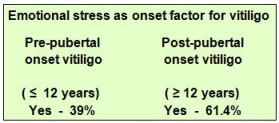 
- Stress contributed to the onset of vitiligo in 61.4% of post-pubescent patients in a 2012 French study. The percentage was lower for those diagnosed before puberty with vitiligo, but still surprisingly high at 39%.
- A 2008 report from Belgrade University in Serbia pointed out that not only did up to 80% of patients with autoimmune disease report major emotional stress before their disease onset, but their disease then created significant stress in their lives, leading to a vicious cycle of stress-disease-stress-disease.
- More than 65% of vitiligo and alopecia areata patients experienced stressful events prior to diagnosis according to a study in Bucharest, Romania published in 2007. Thirty-two vitiligo patients were included in the study.
- A 2006 publication on a study headed by King’s College, London found that a stressful event preceded the diagnosis of vitiligo in 54% of vitiligo patients out of a total of 87. Participants were asked to cite whether they thought that a stressful event caused their disease and to describe that event and the timing of symptoms and disease diagnosis. Results were statistically significant and consistent with earlier studies; however, this particular study did not find that stress made the disease worse.
- A 2013 review article in World Journal of Dermatology summarized several studies reporting that up to 65% of vitiligo patients cited stressful events before the development of their disease.
*All studies are referenced in the Bibliography.
Stressful events cited in these studies included loss of loved ones by death or separation; death or other loss of a close friend; relocation leading to loss of friends, a job and/or familiar surroundings; accidents and injuries; marital or financial problems; “personal” problems; physical illnesses, and changes in eating or sleeping habits. It’s interesting to note that sometimes an event that is generally seen as positive can still bring major stress into someone’s life. Examples include moving into a new home, enduring home renovations, relocating to a new city, starting a new job or school, or having a baby. Excessive exercise also has been shown to produce stress with negative effects on the body and immune system. Finally, while sometimes one stressor might not be enough to cause major stress along with physical repercussions, a combination of stressors together can be enough to create major stress.
Can stress make a person more prone to having
a flare once a person’s disease is established?
The anecdotal answer would be yes, stress can also trigger a relapse of vitiligo. Though limited research has shown a connection between stress and relapse of other autoimmune diseases, scientific research specific to vitiligo on this subject does not seem to be available. When we look at the science of how stress affects the immune system – especially in an individual whose immune system is not functioning perfectly or is prone to dysfunction, it certainly makes sense in scientific terms that stress can exacerbate disease and keep a disease process going.
Stress is undoubtedly a part of having vitiligo. First of all, just having a chronic illness creates stress. Chronic illness changes one’s life and adds countless burdens, including the struggle to find and maintain support, to create and sustain a good doctor-patient relationship, to deal with symptoms and learn to manage one’s disease on a day-to-day basis, and to cope with reactions from friends, family and/or colleagues who don’t always understand.
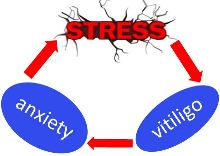  Additional stressors come with having vitiligo. The recurring cycle of stress and its impact throughout the lives of vitiligo patients have been cited in many studies. One of the most recent studies, by Noh et al in 2013, involved 60 patients with vitiligo and an equal number of normal controls. Investigators found a significantly higher level of general anxiety, private body consciousness, and diminished quality of life in vitiligo patients compared to healthy controls. Documentation of the negative impact on social encounters and sexual relationships, as well as an increased incidence of emotional disturbances such as embarrassment, anger, worry or frustration has frequently been cited in vitiligo patients. Additional stressors come with having vitiligo. The recurring cycle of stress and its impact throughout the lives of vitiligo patients have been cited in many studies. One of the most recent studies, by Noh et al in 2013, involved 60 patients with vitiligo and an equal number of normal controls. Investigators found a significantly higher level of general anxiety, private body consciousness, and diminished quality of life in vitiligo patients compared to healthy controls. Documentation of the negative impact on social encounters and sexual relationships, as well as an increased incidence of emotional disturbances such as embarrassment, anger, worry or frustration has frequently been cited in vitiligo patients.
VSI Survey on Stress and the Onset of Vitiligo
In the Winter 2012 VSI newsletter, we published the results of a survey that assessed the link between stressful events and the onset of pigment loss as well as the time that elapsed between the two occurrences. The survey inspired 145 vitiligo patients to respond. The most frequently cited stressors included a family problem or concern for a family member, a death in the family, loss of a job or difficulties in the workplace, and marital problems. Two or more stressful situations were cited by 38.2% of respondents. The largest percentage developed vitiligo within three months of experiencing major stress, and more than half developed vitiligo by the 6-month mark. The remainder of respondents developed vitiligo within a year of facing a stressful event. To view the full survey responses: Click Here
What is the Science?
Numerous studies have looked at how the nervous, endocrine and immune systems are involved in the reaction to stress. Some physical responses to stress are similar for everyone regardless of their health, while other responses occur only in those predisposed to or who already have a dysfunctional immune system, such as in allergies, asthma and autoimmune disease.
We've already touched on Dr. Sternberg's work in neuroendocrinology, with her focus on increased inflammation due to stress and the subsequent dysfunction of stress hormones that would normally calm the inflammatory response. In addition, several studies have shown the effect of stress on T cells, a type of white blood cell that is a key part of the immune system because they control the activity of other immune cells. The impact of stress on T cells differs between healthy subjects and those with vitiligo and other immune-modulated conditions.
A clear example of the effect stress has on T cells was found by a group in Sweden which published findings in 2006 on a study looking at how 41 undergraduate college students reacted to the stress of a major exam. Investigators gauged the students' feelings of stress, stress hormone levels, immune responses and lung function (the latter because they were comparing allergy and asthma patients with healthy controls). Everyone in the study perceived the exam as stressful and demonstrated a sharp increase in regulatory T cells (known as Tregs). However, only those with allergies or asthma experienced an imbalance in these Tregs as well as a decrease in natural killer (NK) cells. NK cells are white blood cells that are another important part of the immune system and work by containing viruses. Tregs keep immune responses in check, serve as a kind of  off-switch once danger has passed and enable any inflammation to subside. When Tregs are thrown out of balance, the T cells cannot function correctly and don't allow inflammation to subside once the stress subsides. This means that inflammation continues, and stress in those who have immune-mediated conditions such as vitiligo may then experience a flare-up. off-switch once danger has passed and enable any inflammation to subside. When Tregs are thrown out of balance, the T cells cannot function correctly and don't allow inflammation to subside once the stress subsides. This means that inflammation continues, and stress in those who have immune-mediated conditions such as vitiligo may then experience a flare-up.
Dr. Caroline Le Poole, who serves on the VSI Medical Advisory Committee, demonstrated a T cell connection in vitiligo when she headed a study published in 2004 that found that depigmentation in vitiligo occurs when there is an influx of T cells in the skin. These T cells are cytokine-secreting cells, and they react with antigens leading to the production of antibodies targeting melanocytes. Dr. Le Poole found that new lesions in vitiligo occurred following major stressors to the skin such as excessive UV exposure or contact with bleaching chemicals.
Antigen- any substance provoking the production of antibodies as an immune response
Cytokine - a protein that acts as a messenger between cells, facilitates communication between immune cells, and often are responsible for increasing inflammation in autoimmune disease |
The mind-body connection is complex and involves many disciplines. A 2013 publication entitled “Psychoneuroimmunologic aspects of skin diseases” emphasizes this point, explaining what the authors call the “psycho-immuno-endocrine-cutaneous system” that includes activities of the brain, immune system and skin. We've already seen how the interaction between mind and body involves physical as well as mental processes, so it's not surprising that numerous fields of study are involved and approach the topic from different perspectives. That’s why it is so important that investigators in immunology, neurology, endocrinology, dermatology and psychology all work together to build on the recent discoveries about stress and vitiligo.
Controlling the Stress in Your Life!
  Richard Lazarus, PhD was a prominent psychologist and professor at the University of California, Berkeley who became known for his work on emotions and stress. He defined stress as an “imbalance between demands and resources” occurring when “pressure exceeds one’s perceived ability to cope.” He also emphasized the importance of coping mechanisms and teaching ourselves how to shape the way we interpret events so that we can better learn to manage the stress in our lives. While he authored many popular books on stress that you might want to read, his classic book from 1984, Stress, Appraisal and Coping, was co-authored with Susan Folkman. Richard Lazarus, PhD was a prominent psychologist and professor at the University of California, Berkeley who became known for his work on emotions and stress. He defined stress as an “imbalance between demands and resources” occurring when “pressure exceeds one’s perceived ability to cope.” He also emphasized the importance of coping mechanisms and teaching ourselves how to shape the way we interpret events so that we can better learn to manage the stress in our lives. While he authored many popular books on stress that you might want to read, his classic book from 1984, Stress, Appraisal and Coping, was co-authored with Susan Folkman.
Because we know that stress can have a profound effect on our health, it’s important to learn how to identify, reduce and control the stress in our lives. In addition to the many references already described, including books by Esther Sternberg, Norman Cousins, and O. Carl Simonton that elucidate the effects of stress on disease, another book that hits close to home specifically addresses skin disease, how stress can affect it, and what you can do about it. Ted Grossbart, PhD, an Assistant Clinical Professor of Psychology at Harvard Medical School and VSI Medical and Scientific Advisory Council member, co-authored Skin Deep: A Mind/Body Program for Healthy Skin. Dr. Grossbart leads a program to help people identify their emotional triggers and reduce their impact.
We found some good tests, listed below, to measure the stress in your own life, and we also offer some tips for dealing with your stress.
Test Your Stress:
A leading stress test still used today was developed in 1967 by psychiatrists Thomas Holmes and Richard Rahe. Holmes and Rahe studied stress and its relationship with illness. To view a copy of their test as well as a full explanation of the Holmes and Rahe Stress Scale, Click here
In addition to measuring stress, the scale can be used to monitor stress in your life. For additional information, a review of the scale as well as a description of the Hassles and Uplifts Scale developed by Kanner et al in 1981, which helps you to add up the more minor stresses that can occur in our lives that together add up to major stress, Click here.
Dr. Grossbart also has a quick quiz on his website for determining whether stress is a problem in your life and affecting your disease. To view this quiz, Click here.
Top Tips for Dealing with Stress:
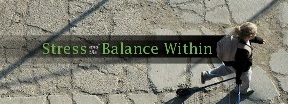
- Identify and learn to recognize stressors
in your life.
- Know your limits and pace yourself.
- Listen to your body and take time out as needed to get through your day.
- Don't be afraid to ask for help.
- Build a support system. To the greatest extent possible, avoid those who are not supportive.
- Educate your friends and family about what you are going through.
- Set realistic expectations and plan ahead.
- Practice relaxation techniques such as meditation.
- Get sufficient rest and sleep every night.
- Eat well! Avoid junk food and too much caffeine and alcohol, and eat nutritiously.
- Get moving every day! If you have not been exercising, start slowly and build up. If you have any major health problems such as cardiovascular or lung issues, consult with your doctor before starting an exercise routine.
- If you are employed, request accommodations as needed because of your medical condition. If you can work from home, you can gain more flexibility with your time and work routine.
- Develop a close working relationship with your doctor(s). Report major changes in your psychological well-being such as depression and anxiety.
- Seek help in lowering your stress level. Consider consulting with a mental health professional to talk about your stress and the effect on your quality of life and your disease. Discuss better methods for coping with stress.
- Avoid triggers for your stress as often as you can. When you can't avoid stress, practice techniques that reduce stress and lean on your support system.
- Add laughter to your life! Make time for friends or to make new friends, and engage in stimulating social and mental activities.
Back to Top


What's On Your Mind?
Q. What can I use to color my eyebrows that have turned white?
My natural hair color is a dark brown, but the vitiligo around my eye has now resulted in some of my eyebrows and eyelashes turning white. I've tried using mascara, as well as an eyebrow pencils, but neither work very well. The mascara is very difficult to work with - it's sticky and messy and difficult to spread, and the eyebrow pencil always seems to wear off very quickly. Do you know of any FDA approved dyes that are safe for vitiligo and that can be used around the eye?
- VSI was unable to find any product testing specific to vitiligo for these types of cosmetics. However, some of our members have reported satisfactory results with
 various other eyebrow-oriented products, such as liquid eyeliner pens, as well as ordinary permanent markers. various other eyebrow-oriented products, such as liquid eyeliner pens, as well as ordinary permanent markers.
Application is very quick, but because you would be applying these products to the eyebrows or eyelashes rather than the skin, as with anything new, it may take a few days practice to get the best results.
The best approach is to begin by holding the product in an upright/vertical position, then rubbing the side of the pen or point of the marker carefully across the brow hairs that you wish to color. The challenge is to color the brow hairs without actually getting it on the skin, which will show up as a distinct mark, making the appearance more obvious and less natural.
For the eyelashes, the liquid eyeliner pen might provide better color and be easier to manage with the thinner point, but either would work. You would hold the pen upright 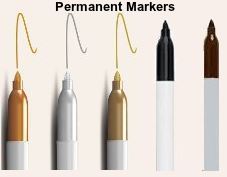  while running back and forth through the lashes, again taking care not to mark the skin. while running back and forth through the lashes, again taking care not to mark the skin.
In America, these products are readily available at most grocery stores, drug stores or big box stores. The permanent markers are very inexpensive and come in a wide variety of colors. The liquid eyeliner pens are a bit more expensive, but are available online as well as in most of the stores mentioned above.
As always, you would want to do your homework to confirm the ingredients and take care to avoid those products that contain chemicals identified as problematic for vitiligo. Unfortunately, many of these products do not include an ingredient list in the store package, so you’ll likely need to look online before purchasing.
In a previous newsletter, VSI asked Ray Boissy, Ph.D., Professor of Dermatology & Cell Biology and Director of Basic Science Research at the University of Cincinnati College of Medicine for a list of the hair dye ingredients known to cause pigment loss. We can only report on chemicals that have been tested for vitiligo, so while the chemicals listed below are known to cause pigment loss, there may be others as yet unidentified.
Known Hair Color Chemicals to Avoid:
Butylated Hydroxytoluene (BHT);
P-Phenylenediamine (aka- para-phenylenediamine -ppd or P-Phenylenediamine)
P-Amonophenol
4-Amino-2-Hydroxytoluene
M-Aminophenol
Benzyl alcohol
P-Aminophenol
Editors note:
According to VSI’s web search, the markers and pen displayed above
do not contain any of the chemicals from the above list. However, you might
want to run your own search prior to use, in case of any changes or updates.
To View “Revlon Colorstay Liquid Eye-Pen” Ingredients, click here,
then select the tab marked “Ingredients.”
To view the Dept. of Health and Human Services “Product Information”
for “Sharpie Chisel Tip Permanent Marker, All Colors,” click here.
To view the Dept. of Health and Human Services
list of products containing p-Phenylenediamine, click here. |

How Did Vitiligo Affect Your Life?
After developing vitiligo, many people struggle emotionally. However, after an adjustment period, some seem to regain their self confidence better than others.
Catherine Tyerman, a postgraduate student from Sheffield University in South Yorkshire, England, contacted VSI seeking our assistance in the recruitment of international participants for a vitiligo research project. The study, conducted via questionnaire, is seeking information about whether the way those with vitiligo typically relate to others (outgoing vs. introverted, self-confident vs not, for example) and cope with difficulties, before developing vitiligo, influences the way they react and/or adjust to living with vitiligo.
Which One Are You?

For additional information, or to participate in the study, click here
Medical News Updates
Enrollment Starts for Vitiligo Patients
in Phase 2 SCENESSE® Trials
 
Clinuvel Singapore Pte Limited has announced that the company has received the green light to start recruiting vitiligo patients for its Phase 2 clinical trials using SCENESSE® combined with narrowband ultraviolet B (NB-UVB) light therapy. Phase 1 trials demonstrated especially exciting and beneficial results for those patients with darker complexions and using the combination therapy. SCENESSE® is administered using a dissolvable implant that is injected underneath the skin.
The new trial (CUV103) will build on the positive results of the Phase 1 trial (CUV102), which was published in July 2013. Steven Thng, MD, is the lead investigator for the Singapore study and collaborated on the study design with Henry W. Lim, MD (Henry Ford Hospital, Detroit), Pearl Grimes, MD (VSI Medical Board Chair), and Mark G. Lebwohl, MD (President of the American Academy of Dermatology).
The latest trial is taking place at the National Skin Centre in Singapore and will enroll about 60 vitiligo patients. Participants must be willing to commit to twice-weekly visits for the first seven months of the ten-month trial. To see all requirements and contact information for the study, see the announcement below in this newsletter’s Research and Clinical Trials section.
Foam Steroid Found to be Superior
to NB-UVB Phototherapy in Treating Vitiligo
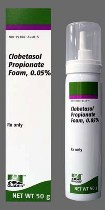  A recent study from Italy and published in Dermatology and Therapy has found that a foam formulation containing the topical steroid clobetasol was superior to narrowband-ultraviolet B (NB-UVB) phototherapy in the treatment of vitiligo patients. Medical records of 60 patients were examined for this preliminary study. Clobetasol is frequently prescribed in ointment form for vitiligo, but using foam – in this case, 0.05% clobetasol propionate foam (CPF) – as the vehicle to deliver the steroid is relatively new. CPF was determined not only to be effective but actually superior to NB-UVB and also appears safe, with only 13.33% in the CPF group experiencing side effects compared to none in the NB-UVB group. While further studies are needed to confirm these results, it appears that the new foam application formulation might offer an excellent treatment option for vitiligo therapy. A recent study from Italy and published in Dermatology and Therapy has found that a foam formulation containing the topical steroid clobetasol was superior to narrowband-ultraviolet B (NB-UVB) phototherapy in the treatment of vitiligo patients. Medical records of 60 patients were examined for this preliminary study. Clobetasol is frequently prescribed in ointment form for vitiligo, but using foam – in this case, 0.05% clobetasol propionate foam (CPF) – as the vehicle to deliver the steroid is relatively new. CPF was determined not only to be effective but actually superior to NB-UVB and also appears safe, with only 13.33% in the CPF group experiencing side effects compared to none in the NB-UVB group. While further studies are needed to confirm these results, it appears that the new foam application formulation might offer an excellent treatment option for vitiligo therapy.
New Clinical Guidelines
Developed for Treating Vitiligo Patients
Clinicians are receiving some long-needed guidance for management and treatment of their vitiligo patients with the April 2014 Experimental Dermatology publication of a treatment algorithm that uses a decision flowchart to examine vitiligo symptoms and suggest appropriate treatments given each scenario, providing a practical guide on how to approach each patient’s treatment plan. The authors, two of whom are on VSI’s Medical & Scientific Advisory Committee (MSAC) (Alain Taieb, MD, PhD, Bordeaux, France and Mauro Picardo, MD, Rome, Italy), developed the treatment algorithm to aid physicians who may be frustrated by how to choose correct treatments for individual cases, provide consistency of care among practices, and provide an important educational tool for physicians who do not treat many vitiligo patients.
VSI MSAC member Dr. Caroline Le Poole and a colleague from Loyola University commented on the importance of this initiative in the May 2014 issue of the same journal:
“The recent publication by Anbar et al…delineating and prioritizing treatment options for vitiligo is both timely and significant. First and foremost, this work brings to the forefront the important message that vitiligo truly is a treatable disease. All too often, patients refrain from seeking treatment as public opinion dictates that vitiligo is not an important disease, there are no effective treatments available, and insurance will not cover attempts to treat. By providing clear guidelines of treatments to be considered, practicing physicians seeing an occasional vitiligo patient will be more readily inclined to explore the possibilities currently available for enhancing the quality of life of this patient group.”
Treatment Stops Vitiligo
Development and Progression in Mice
  A study published in the May 2014 issue of the Journal of Investigative Dermatology confirms earlier findings that a reduction in regulatory immune responses is critical to the development of vitiligo, and goes a step further in offering a potential future therapy for vitiligo patients. Earlier, a 2010 study out of Loyola University demonstrated that regulatory T cells are reduced in the skin of vitiligo patients, a factor that is critical in enabling the disease to progress. These T cells are essential for long-term immune surveillance and the integrity of the skin. Now a new study by investigators at the Medical College of South Carolina and Loyola University has found that increasing regulatory T cells along with the use of a long-known drug prevents development and/or progression of vitiligo in mice. The drug used, rapamycin (also known as sirolimus), is an immune suppressant and antiproliferative (inhibits cell growth) discovered in the 1960s and has been prescribed for a variety of purposes including anti-transplant rejection, diabetes/autoimmunity, and cancer. This study is important on two fronts: First, the success in mice of increasing regulatory T cells and using rapamycin could eventually lead to clinical trials in humans. Second, as our knowledge increases about what goes wrong in the cascade of events leading to vitiligo, the more opportunities we have for developing targeted therapies. A study published in the May 2014 issue of the Journal of Investigative Dermatology confirms earlier findings that a reduction in regulatory immune responses is critical to the development of vitiligo, and goes a step further in offering a potential future therapy for vitiligo patients. Earlier, a 2010 study out of Loyola University demonstrated that regulatory T cells are reduced in the skin of vitiligo patients, a factor that is critical in enabling the disease to progress. These T cells are essential for long-term immune surveillance and the integrity of the skin. Now a new study by investigators at the Medical College of South Carolina and Loyola University has found that increasing regulatory T cells along with the use of a long-known drug prevents development and/or progression of vitiligo in mice. The drug used, rapamycin (also known as sirolimus), is an immune suppressant and antiproliferative (inhibits cell growth) discovered in the 1960s and has been prescribed for a variety of purposes including anti-transplant rejection, diabetes/autoimmunity, and cancer. This study is important on two fronts: First, the success in mice of increasing regulatory T cells and using rapamycin could eventually lead to clinical trials in humans. Second, as our knowledge increases about what goes wrong in the cascade of events leading to vitiligo, the more opportunities we have for developing targeted therapies.
Back to Top

Research & Clinical Trials
Clinuvel Scenesse Clinical Trial
Opportunity in Singapore!
SCENESSE® Phase ll Clinical Trial
Study Location: National Skin Center, Singapore
The National Skin Centre is currently conducting research to assess a new
investigational study drug, afamelanotide (SCENESSE®) - a pigmentation
agent which may help to accelerate the repigmentation of the skin when used
together with the currently available therapy of Narrowband Ultraviolet B (NB-UVB) treatment. SCENESSE® is given in the form of an implant that slowly dissolves
in the body after administration under the skin.
Clinuvel Singapore Pte Ltd is seeking committed vitiligo patients
to participate in a 10-month trial at the National Skin Centre.
To participate in this clinical study,
individuals must meet the following criteria:
- at least 21 years of age
- nonsegmental vitiligo including the head and neck
- skin of mid to dark complexion
- no previous surgical treatment for vitiligo
- no light treatment (including NB-UVB phototherapy)
in the past 6 weeks
- no topical treatments (creams) for vitiligo in the past 4 weeks
- able to attend 10 study visits (around 2-3 hours) for 10 months
and come for NB-UVB twice a week for the first 7 months.
All study visits and NB-UVB treatments will
take place at the National Skin Centre.
Participants will be compensated for travel expenses. Study related
procedures and treatments part of the research will be given at no cost.
Your information will be kept confidential.
If you are interested in participating or would like more information:
Contact: Eric Wang Jun Yen
Phone: +65 90111867 or Email: [email protected] |
Melanocyte-Keratinocyte Transplant Procedure
Opportunity in Detroit!
Comparative Study Using Dermabrasion versus CO2 Laser
and Collagen Dressing versus Vaseline Gauze in MKTP
Principle Investigator: Iltefat Hamzavi, MD
Study Location:
Henry Ford Department of Dermatology,
3031 West Grand Boulevard Detroit, MI 48202
The melanocyte keratinocyte transplant procedure (MKTP) involves transplantation
of the skin cells that produce pigment from your normal skin to the depigmented skin. The procedure takes approximately 4 hours and is done under local anesthesia.
This is a prospective, open-label, parallel study comparing two different techniques
for preparing the depigmented skin (carbon dioxide laser versus dermabrasion)
and comparing two different wound dressings (collagen dressing versus vaseline impregnated gauze) for the melanocyte keratinocyte transplant procedure.
Eligibility Requirements:
- Must be 18 years of age or older
- Must have depigmented patches of skin
Exclusion Criteria:
- History of acral vitiligo (vitiligo on the hands or feet)
- Unstable vitiligo, defined as any new or enlarging areas of
depigmentation within the last 6 months)
- History of thickened scars or keloids
- History of koebnerization (getting new areas of
depigmentation at sites of trauma, such as a cut, scrape, or burn)
The vitiligo patch will be divided into four quadrants. Each quadrant will be
treated with the melanocyte keratinocyte transplant procedure, as follows:
- CO2 laser for denuding the epithelium Collagen dressing
- CO2 laser for denuding the epithelium Vaseline impregnated gauze dressing
- Dermabrasion for denuding the epithelium Collagen Dressing
- Dermabrasion for denuding the epithelium Vaseline impregnated gauze dressing
The patient will return to the clinic for the dressing removal 1 week post-procedure. Repigmentation of the treated areas will be assessed at 1 month, 3 months, and 6 months post-MKTP.
To participate, or for more information, please contact the
Henry Ford Dermatology Research Office at: 313-916-6964. |
Your Opportunity to Move Research Forward!
University of Colorado
Health School of Medicine
International Study to Find Vitiligo Genes

Update!
Additional Patient Volunteers Needed
From the
USA and Canada
Scientists with the International VitGene Consortium project spanning 18 countries are working to understand the biology of vitiligo so that more effective vitiligo treatments can be designed.
Thanks to your involvement, the first two phases of this research project have been extraordinarily successful, discovering many vitiligo genes, and resulting in real breakthroughs in understanding and opening doors to potential new treatments.
The U.S. National Institutes of Health (NIH) has now awarded a large research grant for a third phase of these studies, to discover additional vitiligo genes, deepen understanding, and provide even more new targets for vitiligo treatment. To accomplish this, they need to enroll 3000 additional Caucasian (white) vitiligo patients over the next two years. Participants must be from the USA or Canada and not have previously taken part.
Your participation is vitally needed. Please complete the questionnaire below and then email directly to Dr. Richard Spritz at the University of Colorado School of Medicine using the email address provided at the end of the questionnaire.
Your personal information, by law,
will be kept private and will not be sold or disclosed.
Join with us to work for a vitiligo-free future!
|

Earn Funding for VSI 3 Ways When You Shop!
Please keep VSI in mind when you do any of your online shopping
AMAZON SHOPPING
Amazon.com has all kinds of items in addition to books. As long as shopping is done through this link, Amazon.com, or from the Amazon box on our Community Home Page, VSI will earn fees, based on a percentage of the sale*. The more items members buy, the higher the percentage! Our Vitiligo Library and Store, containing books, articles and products for those with vitiligo, is also powered by Amazon.
iGIVE SHOPPING
iGive.com is another program with an online shopping mall with over 700 stores where you can shop and earn VSI a percentage-coupons are often available as well.
Let friends and family know about iGive so they can support VSI, too. You do have to register for iGive. Once you've registered, you can either shop directly through their "mall" on iGive's website or by downloading their new button, which makes it even easier. iGive also has a search function powered by Yahoo at isearchigive.com (or through the button) that earns VSI a penny per search. The power of numbers makes this also an effective way to support VSI.
GOODSEARCH SHOPPING AND DINING!
GoodSearch and Goodshop are similar to iGive; click “get started” and designate Vitiligo Support International as your cause - you can also register, or sign in through Facebook, to keep track of your donations (registration is not required). Goodshop has some different stores (like Target), though, and also offers coupons and often a higher percentage to VSI. Goodsearch also offers an optional toolbar. Through GoodDining, participating restaurants automatically donate a percentage of your meal purchases to VSI if you (securely) register your credit cards. If you provide reviews of the restaurants afterwards, we earn even more!
* Vitiligo Support International Inc., (VSI) is a participant in the Amazon Services LLC Associates Program, an affiliate advertising program designed to provide a means for sites to earn advertising fees by advertising and linking to Amazon.com. |
|





 Now Visit VSI
Now Visit VSI  And Twitter
And Twitter



 published “The Balance Within: The Science Connecting Health and Emotions” in 2001 in which she discussed the science behind negative emotions and how they influence the way specific hormones function, have an effect on the nerve pathways in the body and ultimately, on the way our immune system functions. She looked at the biology of emotions and disease. By doing so, she started getting the attention of scientists and making the mind-body concept more legitimate to the western way of thinking by looking at the affect of stress on the human body in scientific terms.
published “The Balance Within: The Science Connecting Health and Emotions” in 2001 in which she discussed the science behind negative emotions and how they influence the way specific hormones function, have an effect on the nerve pathways in the body and ultimately, on the way our immune system functions. She looked at the biology of emotions and disease. By doing so, she started getting the attention of scientists and making the mind-body concept more legitimate to the western way of thinking by looking at the affect of stress on the human body in scientific terms.
 off-switch once danger has passed and enable any inflammation to subside. When Tregs are thrown out of balance, the T cells cannot function correctly and don't allow inflammation to subside once the stress subsides. This means that inflammation continues, and stress in those who have immune-mediated conditions such as vitiligo may then experience a flare-up.
off-switch once danger has passed and enable any inflammation to subside. When Tregs are thrown out of balance, the T cells cannot function correctly and don't allow inflammation to subside once the stress subsides. This means that inflammation continues, and stress in those who have immune-mediated conditions such as vitiligo may then experience a flare-up.


 various other eyebrow-oriented products, such as liquid eyeliner pens, as well as ordinary permanent markers.
various other eyebrow-oriented products, such as liquid eyeliner pens, as well as ordinary permanent markers.



